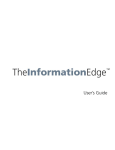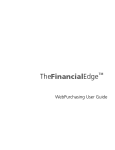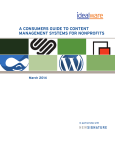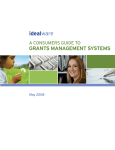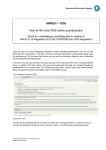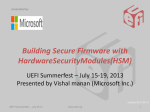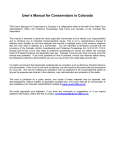Download RAISER`S EDGE USER MANUAL
Transcript
THE ALUMNI AND DONOR DATABASE USER MANUAL Alumni and Donor Database User Manual Updated on 2/12/2010 by Brian McGuire Table of Contents USING THIS MANUAL ................................................................................................... - 1 OUR ALUMNI AND DONOR DATABASE...................................................................... - 1 DATABASE ACCESS AND USE ................................................................................... - 2 GAINING DATABASE ACCESS...................................................................................................................................... - 2 DATABASE PERMISSIONS ............................................................................................................................................ - 2 BEING A RESPONSIBLE ALUMNI AND DONOR DATABASE USER.................................................................................. - 3 - SUPPORT RESOURCES AVAILABLE TO YOU ........................................................... - 4 ADVANCEMENT SERVICES SUPPORT ........................................................................................................................... - 4 THE RAISER’S EDGE USER GROUP .............................................................................................................................. - 5 - ALUMNI AND DONOR DATABASE RECORDS............................................................ - 6 CONSTITUENT RECORDS ............................................................................................................................................. - 6 GIFT RECORDS ............................................................................................................................................................ - 7 ACTION RECORDS ....................................................................................................................................................... - 8 APPEAL RECORDS ....................................................................................................................................................... - 8 EVENT RECORDS......................................................................................................................................................... - 9 - APPENDIX .................................................................................................................... - 10 SEARCHING FOR RECORDS ........................................................................................................................................ - 10 LOGGING OUT OF THE DATABASE ............................................................................................................................ - 12 ALUMNI SUDDS REPORTS ....................................................................................................................................... - 13 BEST PRACTICE FOR SUBMITTING BIOGRAPHIC UPDATES ........................................................................................ - 14 BEST PRACTICE FOR REQUESTING DATABASE INFORMATION ................................................................................... - 14 - Alumni and Donor Database User Manual Updated on 2/12/2010 by Brian McGuire Using This Manual This manual provides an overview of how the Alumni and Donor database is used at Seattle University. It covers your responsibilities as a database user, the support resources available to you, and an overview of the major types of records found in our database. The Appendix section includes information about common database tasks and best practices. You will find links throughout this document to pointing to various resources which contain detailed information about specific subjects. Most of these resources may be found on our Advancement Services website. Questions you have about the contents of this manual may be directed to Advancement Services by emailing [email protected]. Our Alumni and Donor Database The Alumni and Donor database contains biographic, historical communication and gift information about our university donors, alumni, and friends. This database is also used to support our prospect tracking system that helps us gauge and coordinate prospect activity. Having access to this information is an essential part of our Advancement program. Without a sufficient understanding of the needs and goals of prospects and donors, we would not be able to advance Seattle University’s educational and development goals. We currently use Raiser’s Edge as our alumni and donor database. NetCommunity is used to support our alumni and donor online efforts. Both Raiser’s Edge and NetCommunity are Blackbaud products. More information about Blackbaud may be found at their website. Alumni and Donor Database User Manual Updated on 2/12/2010 by Brian McGuire -1- Database Access and Use The following section outlines how you can gain access to the Alumni and Donor database and your responsibilities as a user of the database. Gaining Database Access You must submit a request to gain access to the Alumni and Donor database. You may do so by emailing Advancement Services at [email protected] with your network username. Advancement Services staff will review your request and contact you with any questions. If they have deemed database access is appropriate for you, a login will be provided. Logins are usually restricted to University Advancement personnel only, but exceptions may be made. Once Advancement Services has confirmed a Raiser’s Edge account will be set up for you, contact the Help Desk at extension 5571 to schedule the software installation. Before you are granted access to Raiser’s Edge, you must attend a New User training. You will be required to consent to our Confidentiality policy agreement at that time. Database Permissions Database permissions are set up differently for each user based on that user’s specific needs. Contact Advancement Services at [email protected] to request a change to your database permissions. Typically, an expansion of database permissions will require training using the new features available to you. This approach has been used in the best interests of our constituents and in order to remain compliant to the legislation set out in the Freedom of Information and Protection of Privacy Act (the FOIP Act). Information contained in The Raiser’s Edge is strictly confidential and is not to be disclosed unless it is required for your job. Unauthorized mailings or reviewing records for reasons other than official Seattle University business is prohibited. Please be a good steward of our alumni and donor information. Alumni and Donor Database User Manual Updated on 2/12/2010 by Brian McGuire -2- Being a Responsible Alumni and Donor Database User Access to the Alumni and Donor database comes with responsibilities. You are now a steward of our alumni and donor data. You must safeguard the confidentiality of our alumni and donors as well as record your activities for the benefit of other current and future database users: Attend Trainings – Trainings are held each month in ENGR 302. These are great opportunities to gain hands on experience with new database tools and processes, and to interact with fellow database users in a classroom setting. Advancement Services staff are available to provide personal training as well. Take the time to keep yourself up to date on our policies and database tools. Share your knowledge – As you use the Alumni and Donor database, will accumulate experience and knowledge. Be sure to share tips, tricks and best practices with your fellow database users. Do your part to maintain the integrity of our data by updating our database with new information as you become aware of it. Use the database to track your alumni and donor related activity. If it isn’t in the database, it didn’t happen. Coordinate your efforts with others – Many of the projects we work on overlap with the efforts of other individuals and departments. Communication is key to the success of these efforts. Make other stakeholders aware of your actions, whether that’s planning a mass solicitation or meeting with a prospect. The Alumni and Donor database is a tool for communicating with your fellow users. Pay attention to Raiser’s Edge related communications – Training opportunities, upgrade announcements and requests to log out of the system are common messages sent to the REUsers Outlook distribution list. You are responsible reading these communications as they may impact your work. Free up resources when you don’t need them – When you are logged into the database you may be preventing another user from logging in. When you have a record open you may be preventing another user from working with that record. Log out of the system when you aren’t actively using it. Close out of records when you don’t need to have them open. Maintain data confidentiality – We must respect the privacy of our alumni and donors. Our database contains sensitive information that must only be used for official SU business. To better safeguard this information, do not share your personal login with others. Do not walk away from your workstation without logging out of the database first. If you are working on projects with volunteers who will view alumni and donor data, have them read and sign confidentiality agreement. Follow our policies and procedures – We have set up many policies and procedures that help us maintain a healthy, useful database. Familiarize yourself with those policies and procedures as they relate to your job and projects. These policies and procedures are available for viewing on the Advancement Services website. Alumni and Donor Database User Manual Updated on 2/12/2010 by Brian McGuire -3- Support Resources Available to You There are many support resources available to you when working with our Alumni and Donor database. The Advancement Services department is here to help you, and you may have a Raiser’s Edge expert within your own department. Advancement Services Support Advancement Services supports Seattle University staff in using our Alumni and Donor database. This support includes: Data Entry Support – Request data entry support from Advancement Services if there is not a trained Raiser’s Edge Specialist within your school or department. Customized Reporting/Data Retrieval – Request reports, mailing lists and other types of data pulls. Issues – Request support for miscellaneous projects such as merging a de-centralized database into Raiser’s Edge, determining how to maximize usage and minimize effort, inquire about a policy/procedures or request Raiser’s Edge software enhancement(s). Data Cleanup – Report data issues you find to Advancement Services for review, data cleaning and possible policy change. Training – One on one and group trainings are available Several mailboxes have been set up to field questions and support requests: [email protected]: Used for collecting questions about gifts. Bio [email protected]: Used for collecting biographical updates to RE Constituent records and small data cleaning projects (less than 25 records). [email protected]: Used for collecting RE, NetCommunity and large data project requests (25 or more records) as well as general questions concerning RE and NetCommunity. You may also contact Advancement Services by phone at x6121 (206-296-6121). Alumni and Donor Database User Manual Updated on 2/12/2010 by Brian McGuire -4- The Raiser’s Edge User Group The Raiser’s Edge User Group is a group of SU staff who meet regularly to address issues concerning our alumni and donor database. These issues include software training, data cleanup projects, business rule changes and database coding, to name a few. This group consists of staff members from various parts of campus who use Raiser’s Edge. They are expert users who can field questions you have about using the database. They may also bring your database issues before the entire Raiser’s Edge User group for further discussion. Group membership changes each year. Below is the current membership for fiscal year 2010: Name Leilani Balais Robert Bourke Lindy Boustedt Katie Chapman Christina Faulhaber Josh Hammar Linda Hulten Miranda Lucker Brian McGuire Helen Sernett Ken Shook Department Alumni Relations Albers School of Business and Economics Corporate and Foundation Relations Donor Relations and Events Prospect Research Advancement Services Advancement Services School of Law Alumni Relations Advancement Services Annual Giving Law School Advancement Do not hesitate to contact any one of these group members if you have questions or concerns about our Alumni and Donor database. Alumni and Donor Database User Manual Updated on 2/12/2010 by Brian McGuire -5- Alumni and Donor Database Records The following section describes how Seattle University uses different kinds of Raiser’s Edge record types to track our alumni, donors and friends. For detailed information about the different kinds of Raiser’s Edge records, please refer to the “Raiser’s Edge for Beginners” link located here http://www.seattleu.edu/adv_services/newuser.aspx. Below is a list of the major Raiser’s Edge record types and how they are used at Seattle University: Raiser’s Edge Record Type Constituents Gifts Actions Appeals Events Use by Seattle University Records biographical and contact information about our alumni, donors and friends Records any gift made to Seattle University Records personalized contact between a prospect and a Seattle University staff member Records mass communication between Seattle University and our constituents. These communications may or may not be solicitations Records time, place and attendance for our alumni and donor focused events Constituent Records Records are added to our alumni and donor database regularly. The common types of constituents added to our database are displayed in the diagram below: Alumni and Donor Database User Manual Updated on 2/12/2010 by Brian McGuire -6- Several types of constituents are added periodically throughout the year. These include: Constituent Type Alumni Parents of incoming undergrads Varsity sport season ticket holders Undergrad seniors and Law School 3-L’s Seattle University Staff Add to Database Schedule Each quarter, 2 weeks after grades are due Once a year in October Once a year in December Once a year in January Twice each month Donors and prospects are added to our database on an as needed basis. Advancement Services staff are responsible for adding constituents to the alumni and donor database. If you have a person or organization you would like added to the database, contact Advancement Services by emailing [email protected]. In that request, include the nature of the relationship between the person/organization to be added and Seattle University. Although we do our best to update our faculty and adjunct faculty records, these lists have proven difficult to keep accurate. When communicating with faculty and staff, it is recommended to do so through the faculty and staff Outlook distribution lists. For more information about our specific constituent record business rules, please review the documents found here - http://www.seattleu.edu/adv_services/dataentryprocedures.aspx. Gift Records All gifts to Seattle University are recorded in our Alumni and Donor database as Gift records. Advancement Services staff are responsible for recording all gifts received from both online and offline sources, as well as providing official tax receipts to donors. Advancement Services strives to send out tax receipts within one week of receiving the gift. However, this process can take longer if the gift requires special attention or additional clarification. You may contact Advancement Services at [email protected] if you would like to learn more about gift receipts. To be considered a gift, no services may be received by the donor in exchange. These services include fees paid to attend an event. Such fee payments are not recorded as Gift records. The alumni and donor database has many useful gift reporting features. You may contact Advancement Services if you would like to learn more about pulling your own gift reports. If numbers from your gift reports are intended to be used in a publication or presentation, have Advancement Services pull the report for you. This will ensure gift reporting consistency. Alumni and Donor Database User Manual Updated on 2/12/2010 by Brian McGuire -7- For more information about our specific gift record business rules, please review the documents found here - http://www.seattleu.edu/adv_services/giftscholarshipforms.aspx. Action Records Action records are used to record personalized contact between a prospect and a University Advancement staff member, typically a development officer. Action records can most often be classified as being one of the following types: General notes Action: A communication with a donor or prospect worthy of recording as an archive of routine interactions. General notes can also be used for actions about a donorprospect, such as a strategy discussion or relevant philanthropic information learned from a third party. Recording this type of communication is at a fundraiser’s discretion. Contact Report Action: A discussion with a prospect about that prospect’s commitment, involvement or interest in Seattle University program or initiative, or a discussion with a prospect that reveals key information that should be shared with University Advancement staff. Use of Contact Reports is reserved for major gift level donors and current or potential prospects only. Development officers are responsible for entering their Contact Report Actions into the Alumni and Donor database. For more information about our specific action record business rules, as well as other prospect management policy, please review the documents found here: http://www.seattleu.edu/adv_services/prospectpolicy.aspx Appeal Records Appeal records are used to track mass communications sent to our constituents. These communications include solicitations, event invitations, newsletters and other publications. Appeal assignments let us know who received what communications and when. Email communications are not tracked with Appeal records unless they are solicitations. Advancement Services and Annual Giving staff are responsible for adding new Appeal records and applying them to constituents who receive mass communications from Seattle University. If you are planning on communicating with a large group of constituents, you must work with Advancement Services to pull your distribution list and to have an appeal assigned to each recipient of your communication. If you are planning a solicitation, you must also work with Annual Giving to coordinate the timing. This will help us avoid overlapping solicitations originating from multiple departments. Alumni and Donor Database User Manual Updated on 2/12/2010 by Brian McGuire -8- Event Records Event records are used to track a history of Seattle University alumni and donor events and attendance at those events. Event records are created by Advancement Services or specially trained staff and are managed by the person(s) from the department hosting the event. Location, times and expenses are recorded on Event records, and event managers can use them to track RSVP’s. RSVP lists can easily be pulled from the database. After an event is over, event managers mark who attended and who didn’t on the Event record. Recording event participation in this manner helps us audit the success of our events and our constituents’ level of engagement. University Advancement’s Special Events staff are available for offering guidance for managing Event records and they can also provide advice for pulling off a successful event. For more information regarding Event record business rules and participant tracking, please review the documents found at these locations: http://www.seattleu.edu/adv_services/eventprocedures.aspx http://www.seattleu.edu/adv_services/eventpolicies.aspx Alumni and Donor Database User Manual Updated on 2/12/2010 by Brian McGuire -9- Appendix The following sections outline common user tasks and best practices for working with the Alumni and Donor database. Searching for Records Multiple methods may be used to search for records in Raiser’s Edge. The following instructions focus on searching for Constituent records. Below is a screenshot of a Constituent Record start screen. You can use the “Quick Find” or “Open a Constituent” to begin the search process. You may also click one of the names under “Recently Accessed Records” to bypass the search and open a record you recently worked with. Open a Constituent and Quick Find links. Names of recently opened Constituents. Using Quick Find Type in the first and last name (brian mcguire), or last name comma first name (mcguire, brian), of the Constituent you’re searching for and then click the binoculars or hit “Enter”. Note that searching is not case sensitive. If Raiser’s Edge finds an exact match, that record will open immediately. If multiple or no results are returned, a detailed search window will open instead. Alumni and Donor Database User Manual Updated on 2/12/2010 by Brian McGuire - 10 - Using “Open a Constituent” Clicking “Open a Constituent” will open a search screen with more criteria fields are available to help you find records. The more fields you fill in, the narrower your results will be. Below is a screenshot of this screen displaying the search results for anyone whose last name is “Smith”: Search Results Window Search Criteria Controls There are a few buttons of interest on the right side of this screen: “Open” opens the currently highlighted Constituent record. You may also double click the name of the Constituent in the results window to open the record. “Cancel” closes the search screen. “New Search” removes your existing search criteria, starting you search from scratch. “Previous Search” recalls the criteria you typed the last time you searched for a record. This comes in handy when you search for and open a record, only to find it wasn’t the right one. You can close out of that record and hit “Previous Search” to avoid having to re-enter all your criteria again. “Expand/Collapse Results” makes the results window larger or smaller. Search Tips Type in the first few letters of a name or the numbers of an address. Raiser’s Edge will return names and addresses that begin with what you typed. For example, if you type “mcg” in the last name and “1121” in the address line fields, you will receive anyone whose last name begins with “mcg” and whose preferred street address begins with “1121”. If at first you don’t find the person or organization you’re looking for, modify your search criteria to expand your results. Alumni and Donor Database User Manual Updated on 2/12/2010 by Brian McGuire - 11 - You may also use the up and down arrow keys or click the dropdown icon in any of the criteria fields to select recently used criteria for that field. Use Wildcards If you place an asterisk (*) before your search criteria in a field, it will locate matches that contain any sequence of characters before what you typed. For example, if you type “*berg” in the last name criteria box, you will receive anyone whose last name contains the letters “berg” anywhere in their last name. If you place a question mark (?) in your search criteria text, it will match any single character. For example, if you type “Br?an” in the first name field, you will receive people whose first name is “Brian” or “Bryan” or “Brzan” Check your search flags To ensure the widest possible search, make sure all the search flag boxes below your criteria are checked with the exception of “Exact match only”: Note that some of these checkboxes will be inactivated until you type in search criteria. For example, “Check nickname” will be inactive until you type in First Name search criteria. Logging Out of the Database It is important to log out of the database when you are not using it. Seattle University has a limited number of concurrent Raiser’s Edge user licenses. When you are logged into the system, you may be preventing another from logging in as well. Be considerate of your fellow users’ needs and log out completely each time you finish using the database. Be sure to log out of Raiser’s Edge before you leave work as some nightly maintenance functions require everyone to be logged out. Alumni and Donor Database User Manual Updated on 2/12/2010 by Brian McGuire - 12 - Steps you need to follow in order to log out of the database Go to the File Menu and select “Exit and Sign Out”: Check to see if the Raiser’s Edge stoplight appears at the bottom right of your desktop. If it appears, it means you have not logged off: If the stoplight still appears, you may right-click it and choose to sign-out from there Log out vs. Time out Logging out of the database is not the same thing as being timed out. When you log out, you free up a license for another to use. If you are logged into the database and do not perform any actions for 15 minutes, you will be timed out. When timed out, you are still using a license, which could prohibit another user from logging in. Always remember to log out of the database when you aren’t actively using it. Alumni SUDDS Reports The Seattle University Data Delivery System (SUDDS) is a reporting tool that pulls information from various databases around campus. There are two reports available in SUDDS that allow you to search for alumni contact information without logging into the Alumni and Donor database. These reports reside in the “Alumni” folder which can be found by following this link: https://sudds.seattleu.edu/login.aspx. Prior to accessing these reports, you must have completed the FERPA training and be an Alumni and Donor database user. Alumni and Donor Database User Manual Updated on 2/12/2010 by Brian McGuire - 13 - Best Practice for Submitting Biographic Updates All requests to updates biographical information for alumni and donors should be sent to [email protected]. By doing so, your updates will be entered into the Alumni and Donor database by trained Advancement Services staff. To ensure your updates are processed accurately, please abide by the following guidelines: Consider the number of updates you are submitting. If your updates constituent a large cleanup project (updates to more than 25 records), send your request to [email protected] instead. When requesting updates to Constituent records, look up those Constituents in the database to see if your updates have already been made. If they aren’t, email your update request including enough information to help Advancement Services staff know what record(s) to update. Specifying a constituent ID is a great way to avoid having the wrong “John Smith” updated. If you are requesting someone be added as a new Constituent to the database, include your reason for having that person/organization added. If forwarding email bounces, include the actual bounce error message. Do not send soft bounces such as “mailbox full” and out of office replies. Best Practice for Requesting Database Information All requests for reports, lists, event records and large cleanup projects should be sent to [email protected]. To ensure your request is processed in the most efficient manner, please abide by the following guidelines: Plan ahead and submit your requests well before you need your data. Advancement Services processes many requests from around campus. The sooner you submit your request, the earlier your request will be placed in the request queue. Use the appropriate form to request data. Although this may seem cumbersome at first, it will actually save valuable time, especially if you are working under tight deadlines. These forms ask all the questions required to fulfill your request. Filling out a form at the start will reduce correspondence time spent between you and Advancement Services fleshing out details. Be prompt in your replies to questions concerning your requests. Delayed replies will result in delayed delivery dates. Email messages need to be thoroughly tested before sending. If you are on the test message list, provide your edits in a timely manner. This will ensure your message is sent by the date you requested without embarrassing errors. Be aware that much of the information delivered to you is private alumni and donor data, only to be used for official Seattle University business. Always specify how you intend to use the information you are requesting and always be aware of who you share your Alumni and Donor Database User Manual Updated on 2/12/2010 by Brian McGuire - 14 - information with. If you are working with project volunteers who will have access to your requested alumni and donor data, those volunteers must sign a confidentiality agreement. The table below lists turnaround times for various types of requests: Request Type List Request List Request/Email Blast Combo Email Blast Only Event Record Request Data Cleaning Project Alumni and Donor Database User Manual Updated on 2/12/2010 by Brian McGuire Turnaround 10 full business days 10 full business days 5 full business days 5 full business days Depends on the project - 15 -

















